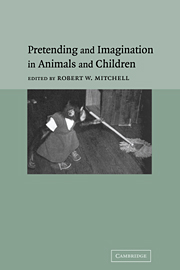Book contents
- Frontmatter
- Contents
- List of contributors
- Foreword by Sue Taylor Parker
- Preface and acknowledgments
- I Historical, developmental, and comparative overviews
- II Pretense and imagination in children
- III Pretense and imagination in primates
- 13 Pretending in monkeys
- 14 Pretending primates: play and simulation in the evolution of primate societies
- 15 Representational capacities for pretense with scale models and photographs in chimpanzees (Pan troglodytes)
- 16 Pretending in free-ranging rehabilitant orangutans
- 17 Seeing with the mind's eye: eye-covering play in orangutans and Japanese macaques
- 18 Possible precursors of pretend play in nonpretend actions of captive gorillas (Gorilla gorilla)
- 19 Pretending culture: social and cognitive features of pretense in apes and humans
- 20 Empathy in a bonobo
- 21 Pretend play in a signing gorilla
- IV Prospects
- References
- Author Index
- Subject Index
18 - Possible precursors of pretend play in nonpretend actions of captive gorillas (Gorilla gorilla)
Published online by Cambridge University Press: 13 August 2009
- Frontmatter
- Contents
- List of contributors
- Foreword by Sue Taylor Parker
- Preface and acknowledgments
- I Historical, developmental, and comparative overviews
- II Pretense and imagination in children
- III Pretense and imagination in primates
- 13 Pretending in monkeys
- 14 Pretending primates: play and simulation in the evolution of primate societies
- 15 Representational capacities for pretense with scale models and photographs in chimpanzees (Pan troglodytes)
- 16 Pretending in free-ranging rehabilitant orangutans
- 17 Seeing with the mind's eye: eye-covering play in orangutans and Japanese macaques
- 18 Possible precursors of pretend play in nonpretend actions of captive gorillas (Gorilla gorilla)
- 19 Pretending culture: social and cognitive features of pretense in apes and humans
- 20 Empathy in a bonobo
- 21 Pretend play in a signing gorilla
- IV Prospects
- References
- Author Index
- Subject Index
Summary
This chapter discusses cases of spontaneous behaviors resembling human pretend play in hand-reared lowland gorillas studied longitudinally over a period of several years. In their early years these gorillas had regular contact with humans and human objects. We discuss instances of behaviors that apparently meet some criteria of pretense (such as object substitution or role enactment). Our argument is that there is little evidence that these apparently pretend behaviors are of the same kind as the pretense shown by human children. However, they might reflect the operation of some basic cognitive mechanisms that played a role in the evolution of pretense in the human lineage. The spontaneous presence of these precursors of pretense may also explain why more complex cases of possible pretense can be induced in apes subject to formal procedures of symbolic training.
The notion of pretend play
Pretend play, also known as symbolic or make-believe play, is a characteristic behavior pattern of the human species that appears in children during the second year of life (Piaget, 1945; Leslie, 1987; other chapters in this volume). It consists of the ability to “act as if” something is the case when it actually is not. For example, acting as if one were a monkey (if one actually is a human, that is) or as if a wooden block were a camera and one were taking pictures (perhaps of an imaginary monkey!). Pretend actions usually display only a fraction or an otherwise modified version of their serious counterparts.
- Type
- Chapter
- Information
- Pretending and Imagination in Animals and Children , pp. 255 - 268Publisher: Cambridge University PressPrint publication year: 2002
- 11
- Cited by



